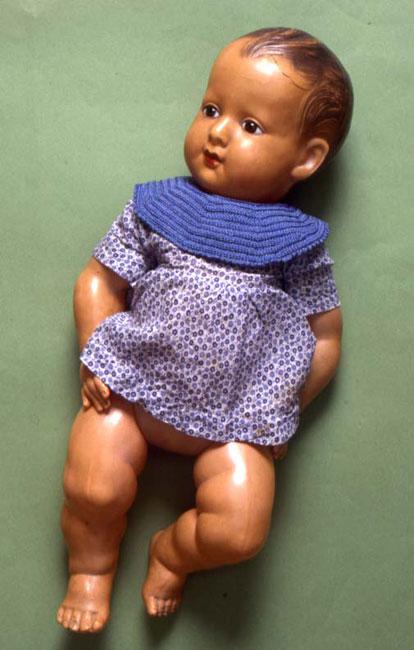David Ehrlich was born in Berlad, Romania, in 1897; his parents were Moshe and Hannah Ehrlich. He married Rivka Mendel (born 1900), and in the late 1920s the couple left Hungary for Paris, taking their two children, Zigu (born 1924) and Aguianak (born 1926), with them. In France the couple had five additional children: Sally (1928), Marcel (1930), Henry (1936), Emil (1938) and Anne-Marie (1940).<br /> David, Rivka and their seven children were apprehended in France and deported to Auschwitz on transport number 84, by way of the transit camp of Malines (Mechelen). All nine family members were murdered.
Yad Vashem Photo Archives, 7858/1

A doll named Baigneur, which belonged to the young Celine Laufgas, (later: Tzviah Carmi), which accompanied her when she fled Paris during the war. The doll, which Tzviah received from her mother in 1940, served her family as a makeshift safe deposit box. The doll's dress was sewn by Tzviah's mother during the war; later on, Tzviah added the collar herself.Tzviah's mother, Hanna, used to hide all the family's money in the doll. While they were in hiding, the money hidden in the doll served to finance all the family's needs: to buy food, to purchase clothing, to pay bribes and more. Tzviah was born in Paris in 1935. She had a sister named Regina (Regina Laufgas Serper). Her parents, Joseph Laufgas and Hannah Laufgas née Wrobel, had emigrated from Warsaw, where they had suffered from financial difficulties. In 1940 the women and children were driven from Paris; the family took refuge in Lyon, which lay within the territory of the Vichy regime. They lived there for close to a year, staying with Joseph's sister, Bela, and her husband Adolph. From Lyon the family moved to Saint-Germain-la-Chambotte in the French Alps, which at the time was under Italian rule. Here they stayed until Mussolini's fall from power, after which they fled to Nice, where Joseph was arrested and sent to Drancy. On the 28th of October, 1943, Joseph was deported to Auschwitz, where he perished. Two or three weeks later, Hanna and her two daughters escaped to Ardentes, a village in central France, where they stayed until the end of the war, together with Joseph's sister, her husband, and Hanna's sister (whose father-in-law was a prisoner of war). This village was also the place of refuge for a further 14 Jewish families.In 1945, after the war had ended, Hanna and her two daughters returned to their apartment in Paris. In 1950 they immigrated to Israel.
Yad Vashem Artifacts Collection
Gift of Celine Laufgas-Carmi

The Jewish immigrants from Eastern Europe wanted to become integrated into French society, which they considered their adoptive country. Approximately one third of them received French citizenship. Most of their children attended the state-sponsored, secular, French school system. The Ort network of vocational schools initiated professional training for Jews, primarily in industry and agriculture. Most of the students in these schools were Jews who had immigrated to France from Eastern Europe. Many of the immigrants were employed in manual labor, but some of them obtained a higher education, studied French, pursued liberal professions and even acquired financial, social, political and intellectual status within French society, some volunteered to serve in the Foreign Legion of the French army. Prominent examples of the “upward mobility” of Eastern European immigrants to France include Helena Rubinstein and the Marxist thinker Charles Rappoport.
Former Polish Jews who had emigrated to France set up Jewish newspapers, which worked alongside the established French Jewish press. Organizations of Jewish immigrants cooperated with French Jewish organizations to produce significant cultural events, such as ceremonies held in 1939 in honor of the 150th anniversary of the French Revolution. Despite such cultural co-operations, many of the immigrants from Poland preferred to pray in synagogues of Jews from Eastern Europe. Some of the French Jews had reservations about the Eastern European Jewish immigrants and so created additional, exclusive, organizations.
During the 1930s many French Jews had reservations about the immigrants, claiming that they constituted an additional increase to the workforce in an economy that was already suffering from unemployment. Another argument was that the new immigrants would seek retribution against Nazi Germany for its actions against Jews, thereby entangling France in another war. In 1936 the Jewish Socialist Léon Blum was elected as Prime Minister. The result was a sharp increase in French antisemitism.
Most Jewish immigrants who successfully obtained French citizenship had immigrated to France from Eastern Europe before the First World War. The majority of the immigrants did not receive French citizenship, even after years of living in France. The importance of this status became very clear during the years of deportation (1942-1944), as the “stateless” Jews were the first to be deported.

